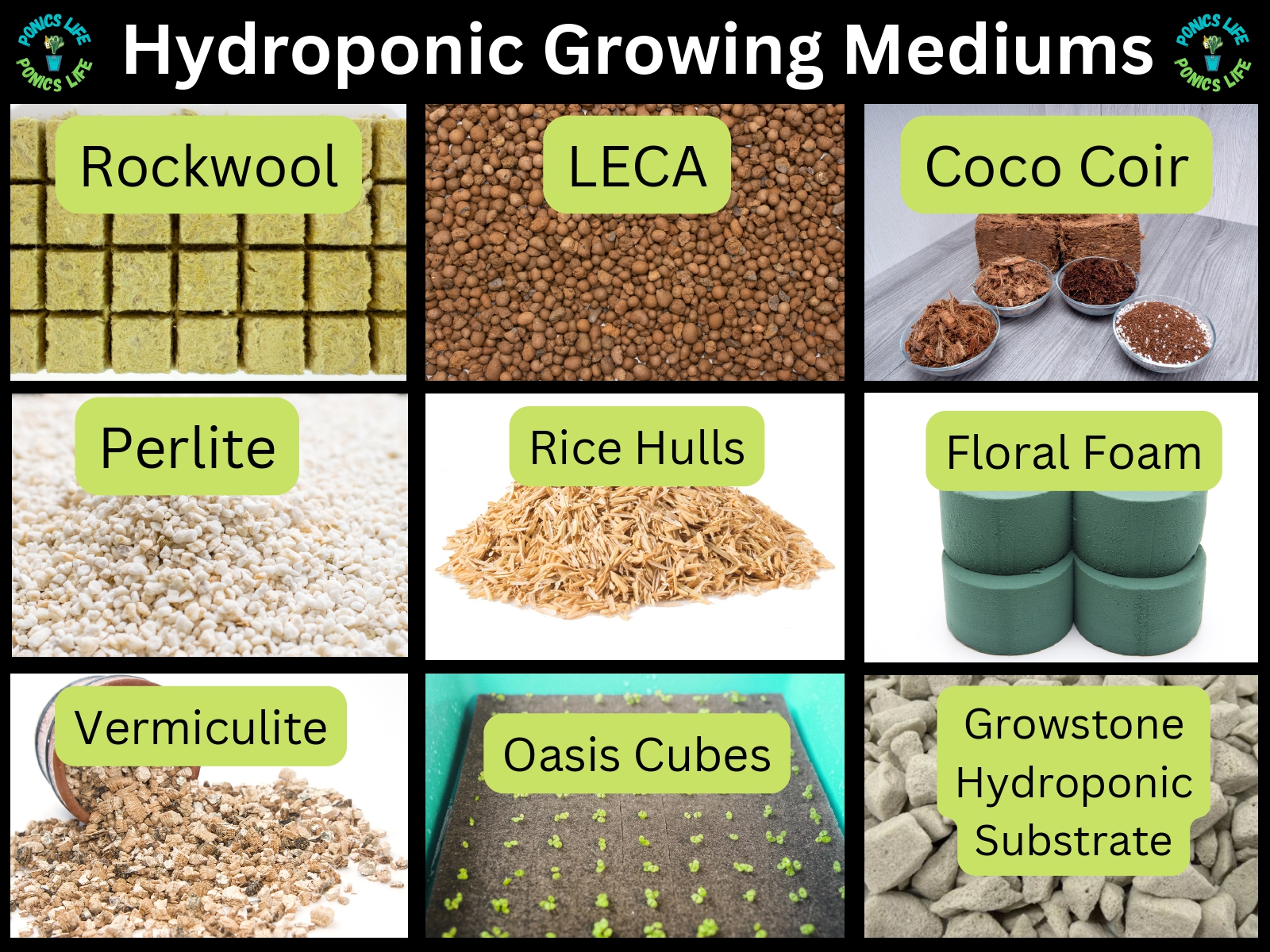Rooted Success: Choosing the Right Growing Mediums
Hydroponic growing mediums are an exciting way to cultivate plants without using soil. So, what exactly are hydroponic growing mediums? Well, think of them as the special “homes” where plants can thrive and receive the nutrients they need to grow.
Instead of traditional soil, hydroponic growing mediums provide a stable foundation for plants to anchor their roots and absorb water and nutrients. These mediums come in various forms, from nutrient-rich coco coir and expanded clay pellets to rockwool and perlite.
The choice of the right hydroponic growing medium depends on the specific needs of your plants, as well as factors like water retention, aeration, and pH balance. So, let’s dive into the fascinating world of hydroponic growing mediums and explore how they can help you grow healthier, more productive plants.
Looking to maximize your hydroponic garden’s potential? Discover the top growing mediums for hydroponic systems for optimal plant growth. These innovative materials provide essential support and nutrition for your plants without the need for soil. Explore a range of options, from nutrient-rich coco coir to lightweight and pH-balanced expanded clay pebbles. Find the perfect hydroponic growing medium that fits your needs and gives your plants the best environment to thrive.

The Importance of Hydroponic Growing Mediums
Hydroponic growing has gained popularity as an innovative and efficient way to cultivate plants in a controlled environment. One crucial element of hydroponics is the choice of the growing medium. Unlike traditional soil-based gardening, hydroponics relies on various materials to support the roots and provide essential nutrients to the plants. In this article, we will explore the different types of hydroponic growing mediums and their benefits, along with tips for choosing the right one for your specific needs.
1. Coco Coir: A Versatile and Sustainable Option
Coco coir is derived from the husk of coconuts and has gained significant recognition as a growing medium in hydroponics. It provides excellent water retention capabilities while also allowing proper aeration for the roots. Additionally, coco coir is sustainable and environmentally friendly, making it an attractive choice for many growers. Its high cation exchange capacity ensures efficient nutrient absorption by the plants, promoting healthy growth and development.
When using coco coir as a hydroponic growing medium, it is essential to properly rinse and buffer it to remove any excess salts and adjust the pH level. This will ensure optimal conditions for the plants to thrive. Coco coir can be used alone or in combination with other mediums, such as perlite or clay pellets, to enhance its drainage capabilities.
BENEFITS:
- Excellent water retention
- Sustainable and environmentally friendly
- High cation exchange capacity for efficient nutrient absorption
- Versatile and can be used alone or in combination with other mediums
2. Rockwool: A Popular Choice for Hydroponics
Rockwool is a widely used hydroponic growing medium due to its versatility and ease of use. It is made from basalt rock and limestone, which are melted and spun into fibers. Rockwool cubes or slabs provide an ideal structure for the plants’ root systems, as they retain moisture while still allowing for proper aeration.
One of the significant advantages of rockwool is its inert nature, meaning it does not contain any nutrients. This allows growers to have complete control over the nutrient solution provided to the plants. It also makes rockwool highly adaptable to different plant species and growth stages, as the nutrient levels can be adjusted accordingly.
BENEFITS:
- Excellent moisture retention
- Provides proper aeration for the roots
- Inert nature allows for precise control of nutrients
- Versatile and suitable for various plant species and growth stages
3. Perlite: Lightweight and Effective
Perlite is a mineral-based growing medium commonly used in hydroponics. It is made from expanded volcanic glass that has been heated to a high temperature. Perlite has excellent water drainage properties, ensuring that the roots do not become waterlogged. This makes it particularly suitable for plants that require good aeration and moisture control.
In addition to its water-draining capabilities, perlite is also lightweight, which makes it easy to handle and transport. Its neutral pH allows for easy adjustment according to the specific needs of different plant species. Perlite can be used as a standalone medium or mixed with other materials, such as coco coir or vermiculite, to enhance its water retention or aeration properties.
BENEFITS:
- Excellent water drainage properties
- Lightweight and easy to handle
- Neutral pH allows for easy adjustment
- Versatile and can be used alone or in combination with other mediums
4. Clay Pellets: Ideal for Hydroponic Systems
Clay pellets, also known as hydroton or expanded clay, are a popular choice for hydroponic systems. They are made from small balls of baked clay that are lightweight and porous. Clay pellets provide excellent aeration and drainage for the plants’ roots while retaining moisture to prevent dehydration.
One of the main advantages of clay pellets is their ability to act as a mechanical filter, preventing clogs in irrigation systems and keeping the water clean. They are also reusable, making them a cost-effective option in the long run. Clay pellets can be used in various hydroponic systems, such as deep water culture or flood and drain, providing a stable and supportive medium for plant growth.
BENEFITS:
- Excellent aeration and drainage properties
- Retains moisture to prevent dehydration
- Acts as a mechanical filter to prevent clogs
- Reusable and cost-effective
5. Vermiculite: Improving Moisture Retention
Vermiculite is a natural mineral that undergoes a process of heating and expansion to create a lightweight and highly absorbent growing medium. It has excellent moisture retention capabilities, which can benefit plants that require a consistently moist environment.
When using vermiculite as a hydroponic medium, it is crucial to monitor and control the moisture levels to avoid overwatering. Vermiculite can be mixed with other mediums, such as perlite or coco coir, to enhance its drainage properties and create a well-balanced growing environment for the plants.
BENEFITS:
- Excellent moisture retention capabilities
- Lightweight and easy to handle
- Can be mixed with other mediums for enhanced drainage
- Suitable for plants that require a consistently moist environment
Key Takeaways: Hydroponic Growing Mediums
- Hydroponic growing mediums are substances that replace soil in hydroponic systems.
- Common hydroponic growing mediums include coco coir, perlite, vermiculite, and rockwool.
- These mediums help support plant roots and provide adequate moisture and oxygen for plant growth.
- Choosing the right growing medium depends on factors like plant type, water retention, and pH level.
- Hydroponic growing mediums play a crucial role in the success of hydroponic gardening.
Frequently Asked Questions
Hydroponic growing mediums play a crucial role in soil-less gardening. Here are some commonly asked questions about hydroponic growing mediums and their answers:
1. What are hydroponic growing mediums?
Hydroponic growing mediums are substances used to support plant roots and provide stability in a soil-less growing system. Unlike traditional soil-based gardening, hydroponics relies on these mediums to anchor the plants and provide access to water, oxygen, and nutrients. These mediums can be inert materials like perlite, vermiculite, and rockwool, or they can be organic, such as coconut coir or peat moss.
Hydroponic growing mediums act as a substitute for soil, providing support, moisture retention, and adequate aeration for the roots. They enable plants to absorb water and nutrients without the need for traditional soil.
2. Which hydroponic growing medium should I choose?
The choice of hydroponic growing medium depends on various factors such as the type of plants you want to grow, the system you are using, and your maintenance preferences. Inorganic mediums like perlite and vermiculite are lightweight, provide good drainage, and are suitable for plants with shorter growth cycles. Organic mediums like coconut coir and peat moss retain more water and are ideal for plants that require higher moisture levels.
When selecting a hydroponic growing medium, consider its water retention capacity, air porosity, pH stability, and availability. Experimentation may be necessary to find the medium that works best for your specific plants and hydroponic setup.
3. How do hydroponic growing mediums affect plant growth?
Hydroponic growing mediums directly impact plant growth by providing stability, oxygen, moisture, and access to nutrients. They offer a controlled environment for the roots, allowing for faster growth and increased nutrient absorption. The selection of a suitable hydroponic growing medium can impact the overall health, productivity, and yield of the plants.
By offering essential support and an optimal balance of water and air, hydroponic growing mediums help plants develop healthy root systems. This enables plants to focus energy on above-ground growth, leading to faster vegetation, larger yields, and healthier plants overall.
4. How do I maintain hydroponic growing mediums?
Maintaining hydroponic growing mediums involves monitoring moisture levels, pH balances, and nutrient availability. Regularly check the moisture content of the medium and adjust watering accordingly to avoid both overwatering and underwatering. pH levels should be regularly measured and adjusted to ensure they remain within the appropriate range for the plants being grown.
Periodically flushing the growing medium with clean water can help prevent nutrient imbalances and salt buildup. This process removes accumulated salts and refreshes the medium, ensuring optimal nutrient absorption. It’s also important to replace or replenish the hydroponic growing medium periodically to prevent compaction and maintain its effectiveness in supporting plant growth.
5. Can I reuse hydroponic growing mediums?
Yes, hydroponic growing mediums can often be reused. Depending on the type of medium and the specific requirements of your plants, you can clean, sterilize, and reuse them for future plantings. Inorganic mediums like perlite and vermiculite can be rinsed, sterilized, and used again in subsequent crops. Organic mediums like coconut coir may require additional processing, such as soaking and buffering, to prepare them for reuse.
However, it’s important to note that some diseases or pests can remain in the growing medium, so it’s essential to thoroughly clean and sterilize it before reuse. Additionally, the effectiveness of the medium may decrease over time, so periodic replacement or supplementation may be necessary to maintain optimal plant growth.

Hydroponics: Growing Media 101
Summary
So, to wrap things up, hydroponic growing mediums are like the soil for plants in a hydroponic system. They help support the roots and provide the nutrients that plants need to grow. Some common mediums include perlite, coco coir, and rockwool. Each medium has its own benefits and drawbacks, so it’s important to choose the right one for your specific needs. Remember to consider factors like water retention, pH levels, and aeration when selecting your growing medium. With the right medium, you can enjoy healthier plants and higher yields in your hydroponic garden.

